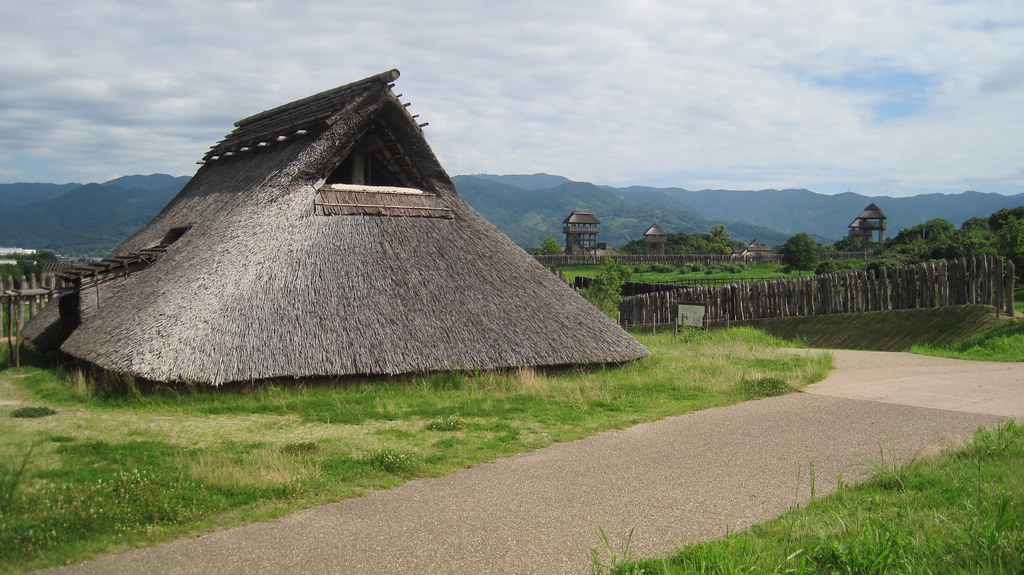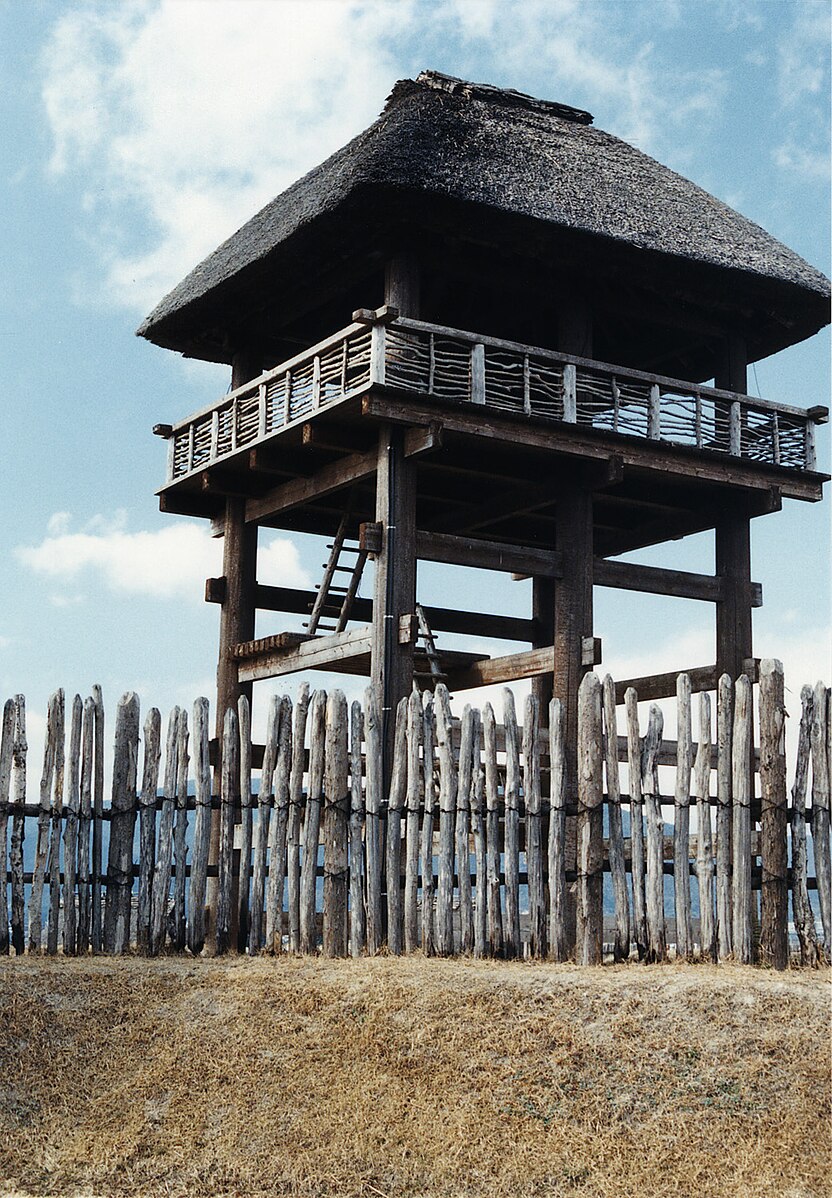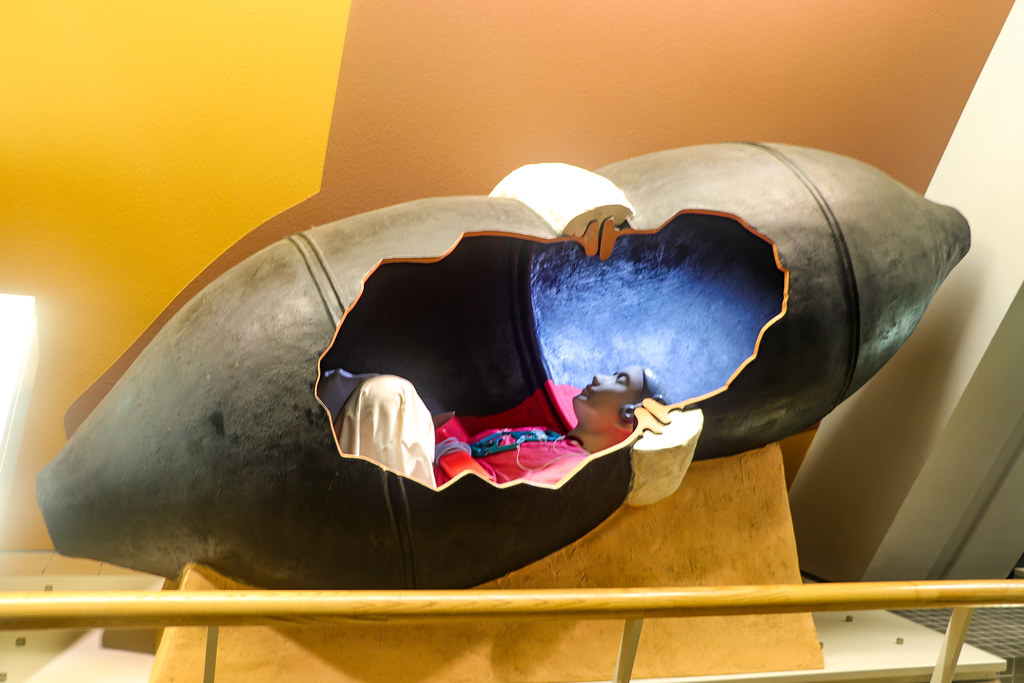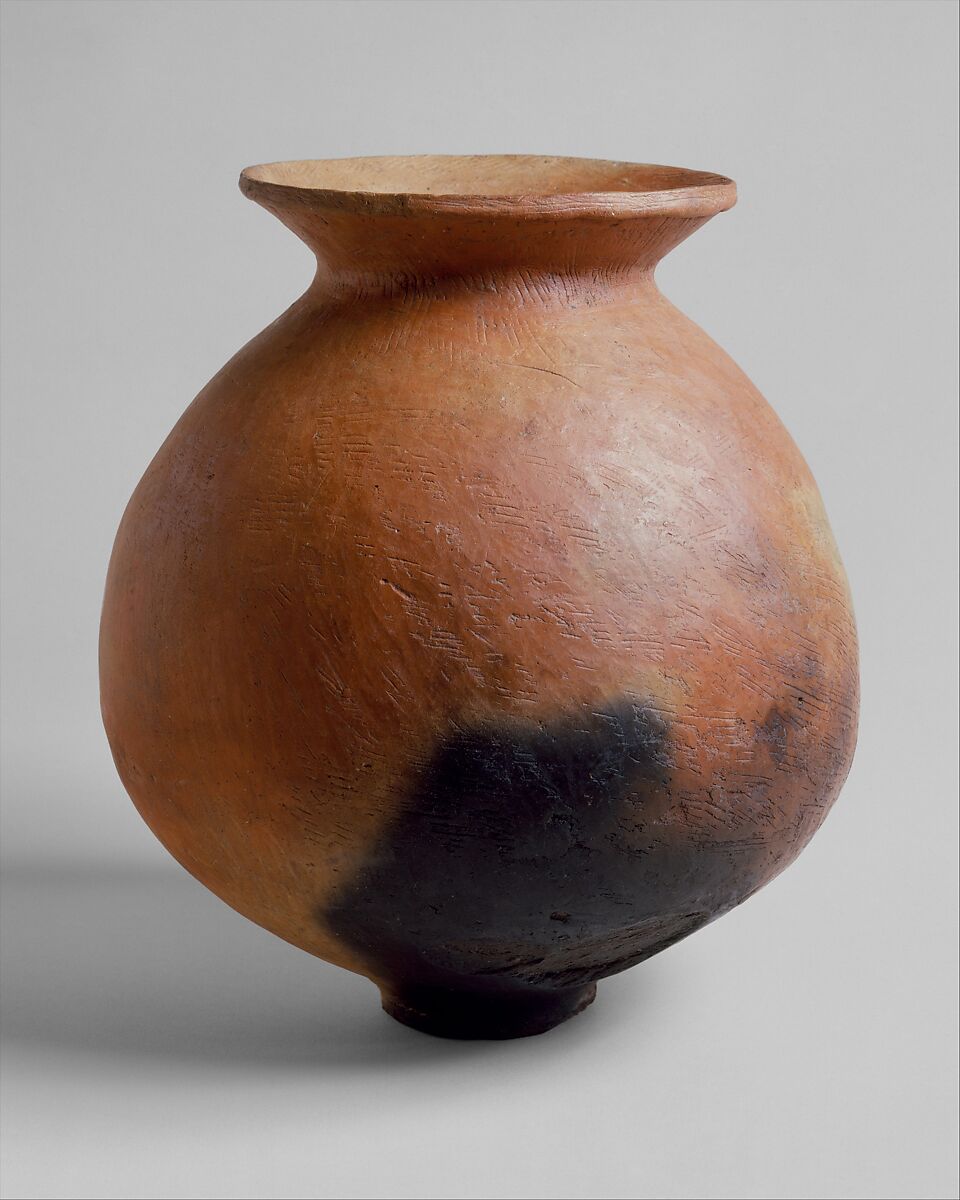5.7: Yayoi Period 300 BCE – 250 CE
- Page ID
- 219982
\( \newcommand{\vecs}[1]{\overset { \scriptstyle \rightharpoonup} {\mathbf{#1}} } \)
\( \newcommand{\vecd}[1]{\overset{-\!-\!\rightharpoonup}{\vphantom{a}\smash {#1}}} \)
\( \newcommand{\id}{\mathrm{id}}\) \( \newcommand{\Span}{\mathrm{span}}\)
( \newcommand{\kernel}{\mathrm{null}\,}\) \( \newcommand{\range}{\mathrm{range}\,}\)
\( \newcommand{\RealPart}{\mathrm{Re}}\) \( \newcommand{\ImaginaryPart}{\mathrm{Im}}\)
\( \newcommand{\Argument}{\mathrm{Arg}}\) \( \newcommand{\norm}[1]{\| #1 \|}\)
\( \newcommand{\inner}[2]{\langle #1, #2 \rangle}\)
\( \newcommand{\Span}{\mathrm{span}}\)
\( \newcommand{\id}{\mathrm{id}}\)
\( \newcommand{\Span}{\mathrm{span}}\)
\( \newcommand{\kernel}{\mathrm{null}\,}\)
\( \newcommand{\range}{\mathrm{range}\,}\)
\( \newcommand{\RealPart}{\mathrm{Re}}\)
\( \newcommand{\ImaginaryPart}{\mathrm{Im}}\)
\( \newcommand{\Argument}{\mathrm{Arg}}\)
\( \newcommand{\norm}[1]{\| #1 \|}\)
\( \newcommand{\inner}[2]{\langle #1, #2 \rangle}\)
\( \newcommand{\Span}{\mathrm{span}}\) \( \newcommand{\AA}{\unicode[.8,0]{x212B}}\)
\( \newcommand{\vectorA}[1]{\vec{#1}} % arrow\)
\( \newcommand{\vectorAt}[1]{\vec{\text{#1}}} % arrow\)
\( \newcommand{\vectorB}[1]{\overset { \scriptstyle \rightharpoonup} {\mathbf{#1}} } \)
\( \newcommand{\vectorC}[1]{\textbf{#1}} \)
\( \newcommand{\vectorD}[1]{\overrightarrow{#1}} \)
\( \newcommand{\vectorDt}[1]{\overrightarrow{\text{#1}}} \)
\( \newcommand{\vectE}[1]{\overset{-\!-\!\rightharpoonup}{\vphantom{a}\smash{\mathbf {#1}}}} \)
\( \newcommand{\vecs}[1]{\overset { \scriptstyle \rightharpoonup} {\mathbf{#1}} } \)
\( \newcommand{\vecd}[1]{\overset{-\!-\!\rightharpoonup}{\vphantom{a}\smash {#1}}} \)
\(\newcommand{\avec}{\mathbf a}\) \(\newcommand{\bvec}{\mathbf b}\) \(\newcommand{\cvec}{\mathbf c}\) \(\newcommand{\dvec}{\mathbf d}\) \(\newcommand{\dtil}{\widetilde{\mathbf d}}\) \(\newcommand{\evec}{\mathbf e}\) \(\newcommand{\fvec}{\mathbf f}\) \(\newcommand{\nvec}{\mathbf n}\) \(\newcommand{\pvec}{\mathbf p}\) \(\newcommand{\qvec}{\mathbf q}\) \(\newcommand{\svec}{\mathbf s}\) \(\newcommand{\tvec}{\mathbf t}\) \(\newcommand{\uvec}{\mathbf u}\) \(\newcommand{\vvec}{\mathbf v}\) \(\newcommand{\wvec}{\mathbf w}\) \(\newcommand{\xvec}{\mathbf x}\) \(\newcommand{\yvec}{\mathbf y}\) \(\newcommand{\zvec}{\mathbf z}\) \(\newcommand{\rvec}{\mathbf r}\) \(\newcommand{\mvec}{\mathbf m}\) \(\newcommand{\zerovec}{\mathbf 0}\) \(\newcommand{\onevec}{\mathbf 1}\) \(\newcommand{\real}{\mathbb R}\) \(\newcommand{\twovec}[2]{\left[\begin{array}{r}#1 \\ #2 \end{array}\right]}\) \(\newcommand{\ctwovec}[2]{\left[\begin{array}{c}#1 \\ #2 \end{array}\right]}\) \(\newcommand{\threevec}[3]{\left[\begin{array}{r}#1 \\ #2 \\ #3 \end{array}\right]}\) \(\newcommand{\cthreevec}[3]{\left[\begin{array}{c}#1 \\ #2 \\ #3 \end{array}\right]}\) \(\newcommand{\fourvec}[4]{\left[\begin{array}{r}#1 \\ #2 \\ #3 \\ #4 \end{array}\right]}\) \(\newcommand{\cfourvec}[4]{\left[\begin{array}{c}#1 \\ #2 \\ #3 \\ #4 \end{array}\right]}\) \(\newcommand{\fivevec}[5]{\left[\begin{array}{r}#1 \\ #2 \\ #3 \\ #4 \\ #5 \\ \end{array}\right]}\) \(\newcommand{\cfivevec}[5]{\left[\begin{array}{c}#1 \\ #2 \\ #3 \\ #4 \\ #5 \\ \end{array}\right]}\) \(\newcommand{\mattwo}[4]{\left[\begin{array}{rr}#1 \amp #2 \\ #3 \amp #4 \\ \end{array}\right]}\) \(\newcommand{\laspan}[1]{\text{Span}\{#1\}}\) \(\newcommand{\bcal}{\cal B}\) \(\newcommand{\ccal}{\cal C}\) \(\newcommand{\scal}{\cal S}\) \(\newcommand{\wcal}{\cal W}\) \(\newcommand{\ecal}{\cal E}\) \(\newcommand{\coords}[2]{\left\{#1\right\}_{#2}}\) \(\newcommand{\gray}[1]{\color{gray}{#1}}\) \(\newcommand{\lgray}[1]{\color{lightgray}{#1}}\) \(\newcommand{\rank}{\operatorname{rank}}\) \(\newcommand{\row}{\text{Row}}\) \(\newcommand{\col}{\text{Col}}\) \(\renewcommand{\row}{\text{Row}}\) \(\newcommand{\nul}{\text{Nul}}\) \(\newcommand{\var}{\text{Var}}\) \(\newcommand{\corr}{\text{corr}}\) \(\newcommand{\len}[1]{\left|#1\right|}\) \(\newcommand{\bbar}{\overline{\bvec}}\) \(\newcommand{\bhat}{\widehat{\bvec}}\) \(\newcommand{\bperp}{\bvec^\perp}\) \(\newcommand{\xhat}{\widehat{\xvec}}\) \(\newcommand{\vhat}{\widehat{\vvec}}\) \(\newcommand{\uhat}{\widehat{\uvec}}\) \(\newcommand{\what}{\widehat{\wvec}}\) \(\newcommand{\Sighat}{\widehat{\Sigma}}\) \(\newcommand{\lt}{<}\) \(\newcommand{\gt}{>}\) \(\newcommand{\amp}{&}\) \(\definecolor{fillinmathshade}{gray}{0.9}\)Introduction
The concept of gold, the shiny material discovered as nuggets or in veins, was a standard of wealth and supremacy for centuries. In 1784, a rice farmer was mending an irrigation ditch and noticed a shiny object wedged in some rocks. Supposedly, the emperor of China gave a visiting diplomat from Wa (Japan) a gold seal (5.7.1), and the incident was recorded in the Book of the Later Han. The seal has been thoroughly studied, and multiple ideas of the seal have been considered. However, Kobayashi Tsunehiro, an expert in the field, declared. "As a result of detailed investigations of the original seal on two or three occasions from a whole host of angles, I have come to the conclusion that it is the very seal presented by the Guangwu Emperor."[1] The open question is why the emperor gave a seal to the diplomat. Some historians believe the emperor was telling the diplomat that the place of Wa was a Chinese vassal state of the Han dynasty. Others think it was a gift between rulers, and some believe it is a hoax. Today, the seal still represents the first recorded history of Japan's existence as a nation.

The Yayoi culture followed the long-lasting Jomon culture in Japan. Around 400 BCE to 300 BCE, immigrants migrated from the mainland areas of China and Korea, integrating with the Jomon and developing the Yayoi culture. The immigrants brought new metallurgy and agriculture technologies to Japan into the Iron Age. Ancient Chinese historians called the Yayoi' the people of Wa'. With the latest technologies, the Yayoi moved from the hunter-gatherer Jomon to an agricultural society.
The island was buffeted by summertime monsoon winds from the ocean, bringing rain and water to grow rice. The farmers terraced and constructed irrigation systems to support their agriculture. "Apart from indirect evidence of rice growing, such as stone sickles and wooden hoes, charred grains of rice and chaff have been found in jars and imprinted on pots."[2] The people moved from stone implements to metal tools and developed a robust agricultural environment. As the population grew, the elite started controlling local resources, food, and access to metal. "The Chinese chronicles reveal that Yayoi society was a highly stratified society: there were different classes of people with differing status. Enslaved people were ranked the lowest.[3]
Although the Yayoi's political structure was poorly documented, historians believe they gathered themselves into clan nations with a defined leader in larger villages. During the early period of the Yayoi, archaeological records document community chiefs in contact with Korean chieftains. Chinese documents during the later period document the title of 'wang' to some of the insular chiefs. Some later records identified specific graves with many valuable grave goods attributed to a chief. Swords, beads, and Chinese mirrors seemed to be essential items, and arrowheads, shells, and tools were commonly found in graves.[4]
Social practices, structures, and societal norms were created with the growth of people populating consolidated areas. Rituals were designed to define how the people lived and even processes for those who died. "In many cases, cemeteries with extremely large jar burials, often with separate elite mortuary compounds marked by a ditch or rectangular mounds, were found at the corners of the regional centers. A large rectangular building was often built nearby, and many such buildings were repeatedly rebuilt on the same spot."[5]
Usually, Yayoi villages were like the previous Jomon dwellings with pit houses, thatched roofs, and dirt floors. Many structures in the villages were constructed on stilts to store rice and other foods. Large moats or ditches generally surrounded villages to protect the village. Each area also had defined burial sites.
Yoshinogari
Currently, the most extensive Yayoi ruins excavated is at Yoshinogari (5.7.2). The site was large, and historians believed this was probably a substantial location. Yoshinogari was dated between the 3rd century BCE and the 3rd century CE. The site was large and contained large numbers of artifacts used by the people and defining the culture of the Yayoi. Historians believe there were several small units within the larger settlement. The smaller units had a king or leader whose residence was surrounded by ordinary residents.

On top of a hill, archaeologists located over 130 pit buildings and twenty storage structures scattered throughout the other buildings. Using historical data, archaeologists have re-created several of the buildings on the site. The re-created pit house (5.7.3) is formed over a sunken pit. The thatched roof covers the building down to the ground. Inside, the roof was supported by upright posts holding the roof beam. The structure has the appearance of an early A-frame house. The entrance was covered, and stairs led down into the ground. The floor was simple dirt. The early Yayoi collected their food supplies in deep pits before constructing large storehouses. The warehouses (x.x) were built on pillars off the ground with wooden floors and thatched roofs. As part of the construction, elaborate rat protectors were installed on the top of each pillar, keeping the rodents away from the grains.
Surrounding the combinations of buildings were different styles of moats, fences, and ditches. Around the outside of the whole village was the first sizeable defensive set of moats. The smaller units with a leader and some followers constructed their buildings with moats, double ditches, or fences. Watchtowers (5.7.4) were elevated high above the ground and constructed to guard on all four sides. The roofs were the usual thatch on the tall pillars and platform. Different sets of small units might have a watchtower, letting the ruler maintain order. As the population increased and the need to control food was essential, warfare between the small units occurred, and the need for defense was critical.



In the Yayoi period, burial mounds were common and located in designated places. In one site, over 2,000 burial jars were found. Some jars were situated inside the significant moat, and others were outside. Artifacts in the jars alongside the bodies and the jars' location might represent a distinction in status. A large pit was dug, and the jar was inserted into the hole. Then, the burial mound was made from stamped earth with layers of clay and loam alternated and piled to form a mound (5.7.6). The large ceramic jars (5.7.8) were made of unglazed clay in two forms. One style was a two-piece jar (5.7.7) split down the middle. Half of the body was placed in one jar, and another jar slid over the rest of the body, and the openings were sealed. The other type was a simple jar and a flat stone for the lid. Historians do not know who used each style; however, social standing may be a reason. The jars required significant manufacturing production to bury all the people. Most of the jars only contained a body; however, a few also had mirrors, shells, or weapons.
"Human skeletal remains from more than 300 individuals have been recovered from jar burial and were probably imbedded in the corpses at burial. A similarly violent fate seems to have befallen another individual in whose burial jar twelve arrowheads were recovered. One headless skeleton was also found, and the individual is presumed to have been beheaded, perhaps after death. This evidence has been used to support the now prevalent view of the Yayoi as a time of widespread warfare."[6]



Weaving
The skill of weaving and the necessary tools came to Japan with immigrants from the continents. The wooden looms, shuttles, and thread used by the Yayoi were the same style as those on the mainland. "Thread was spun from bast fibers of ramie, hemp or kudzu vine on spindles fixed with spindle whorls (upper left), while cloth was woven on simple backstrap looms or ground looms."[7] The type of cloth used in the burial jars relayed information about the weaving process and Yayoi clothing.
The Yayoi clothing (5.7.9) was simply made on a loom, creating a piece of cloth the width of a shoulder, and pieces of cloth were sewn together. Men wore a draped simple Yokohabai tied with fabric around the waist while women added an overdress or Kantoi. The ordinary person's clothing was plain and unadorned. A person with a higher status might wear clothing dyed a color or decorative belting. Archaeologists found pieces of fabric in the burial jars of linen or silk. Silkworms were raised by the Yayoi using spinning techniques like those found in China.
Pottery
"In striking contrast to Jomon pottery, Yayoi (5.7.10, 5.7.11) vessels have clean, functional shapes. Nonetheless, the technical process of pottery making remained essentially the same, and likely, women using the coil method continued to be the primary producers. Two technical differences, however, are significant: the fine clay surfaces of Yayoi vessels were smoothed, and clay slip was sometimes applied over the body to make it less porous. Many Yayoi vessels resemble pots found in Korea, and some scholars have proposed that the Yayoi style originated in that land, first in northern Kyushu and gradually spreading northeastward. Nevertheless, some pieces clearly show the influence of Jomon ceramics, leading others to speculate that Yayoi wares were the product of an indigenous evolution from the less elaborate Jomon wares of northern Kyushu."[8]
Yayoi potters created long-necked jars, basins, wide-mouthed pots, and bowls on pedestals with added geometric patterns for decoration. The pottery looked like it was made on a potter's wheel; however, the potters used the coiling method and shaped it with a tool. Thousands of pieces and whole vessels were excavated in Yoshinogari, including the usual bowls, jars, or steamers used daily. In some locations, the amount of pottery residue or debris indicated a pottery factory.

Bells
Metallurgy, especially bronze and iron, was imported from the mainland. Iron was used for weapons, agricultural tools, and ritual implements, including the special bell (dotaku). During the Yayoi period, the distinctive bells (5.7.12) were believed to be based on a Korean-style bell. The bells do not have a clapper and create a sound by striking it with a mallet. The dotaku were cast in bronze with protuberances and a handle along the edges. Decorations of people, animals, or geometric patterns covered the outside surface of the dotaku. Dotaku were found buried singly or in large groups. Historians believe the dotaku meant more than just a simple bell for music, and the location of some large dotaku groups surprised historians. The later dotaku also had very thin walls and did not resonate; therefore, it was not a musical instrument.

"The Yayoi would mark the transition of Japanese society from bands of hunter-gatherers with little contact with others to an agrarian, metalworking, political, and militarized society. The Yayoi set the foundations for what would now be known as medieval Japan with the introduction of rice-growing and metalworking, which allowed for population expansion and increased weapons and armor production for military purposes. The development of clans, kingdoms, and the class system would eventually lead to the system of daimyo, samurai, and the Chrysanthemum Throne with a line of emperors that would remain unbroken to this day."[9]
Breaking down the main points of Japan's second historical era: the Yayoi Period! (~1000 BCE - 250 CE)
[1] The Discovery of the Gold Seal in 1784 and the Waves of Historiography Ever Since
[2] Mason, R., Gaiger, J. G., (2011). History of Japan: Revised Edition, Tuttle Publishing
[4] Barnes, G., (2007). State Formation in Japan: Emergence of a 4th-Century Ruling Elite, Routledge
[5] Mizoguchi, K., (2013). The Archaeology of Japan: From the Earliest Rice Farming Villages to the Rise of the State, Cambridge University Press, p. 107
[6] Mark Hudson, M., Gina L. Barnes, G. L., (Summer, 1991). Yoshinogari. A Yayoi Settlement in Northern Kyushu, Monumenta Nipponica, 46(2), Sophia University, p. 224.
[7] Barnes, G. L. (2015). Archaeology of East Asia: The Rise of Civilization in China, Korea and Japan, Oxbow Books.
[8] Metropolitan Museum of Art, Yayoi Culture (ca. 4th century B.C."3rd century A.D.)". Heilbrunn Timeline of Art History, October 2002
[9] Hoang, T. (2016, March 10). Yayoi Period. Ancient History Encyclopedia.


